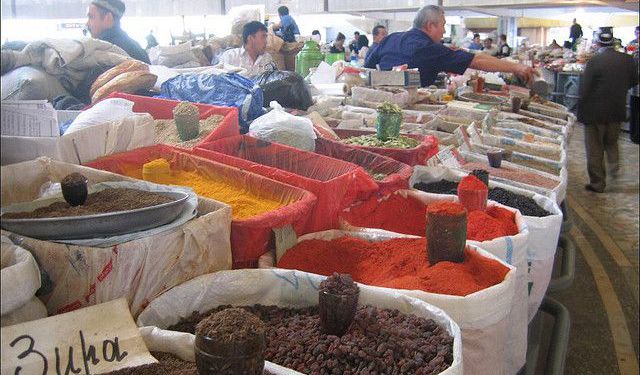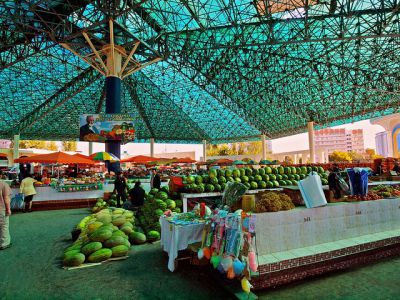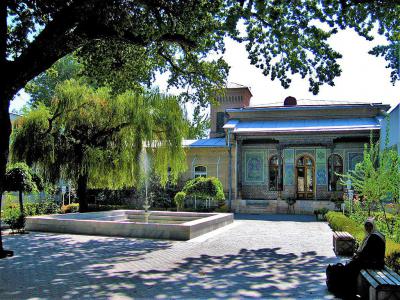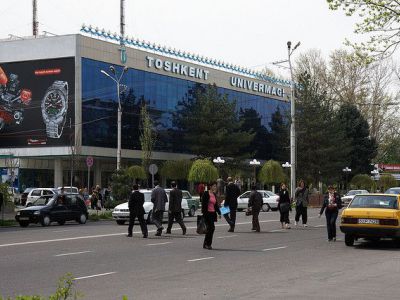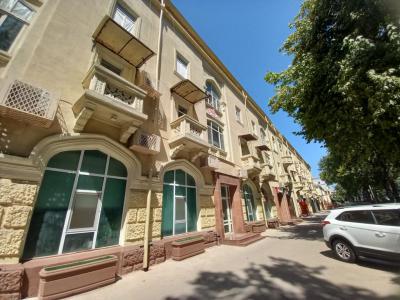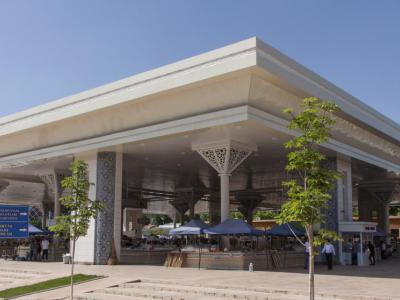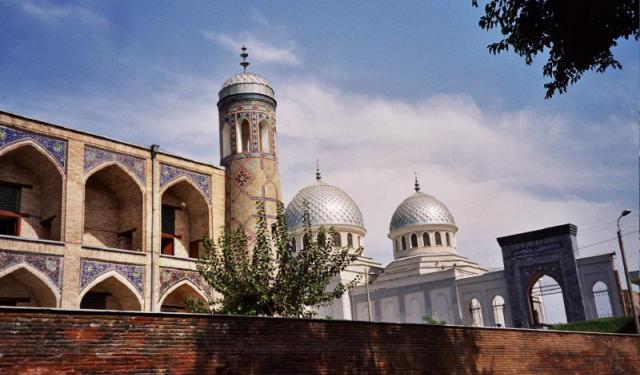Shopping in Tashkent (Self Guided), Tashkent
In the East they say, "A guest on your doorstep is happiness in your home!". Indeed, the Uzbeks, like no other people, are happy to welcome foreigners to their exotic world of aromas, tastes and cordial relationships manifested in authentic local food and products. In Tashkent you can find both of these, and in a great variety, on the street markets (bazaars), in smaller shops and big malls (like the former TsUM, a remnant from the Soviet era), and even museums (such as the Museum of Applied Arts).
Among other things, the capital of Uzbekistan is rich in bazaars. Countless in number, large and small, but always colorful and each with its own history spanning several centuries, they form an integral part of the city. There you can feel like a brother to everyone and is where pilaf (a Middle Eastern dish of rice, vegetables, and spices, typically added with meat or fish) tastes the most delicious. It is also where other exclusive foods, not found anywhere else, are offered in rich supply.
Once considered a bit unsightly for tourists, in recent years the most prominent local markets, like Chorsu, Alai and Mirabad, have been spruced up and preserved for their unique ability to spark urban revitalization, foster community diversity and improve public health. Due to its respectable appearance and beautifully designed central entrance, Alai Bazaar, as a rule, finds itself among the most photographed Tashkent attractions.
Outside bazaars, perhaps one of the best areas for shopping in Tashkent is Alisher Navoi Avenue. Often referred to as the main street of the city, this thoroughfare is ideal for both lovers of excursions and shopaholics, being full of souvenir shops selling crockery, carpets, bags, ethnic attire, knives and fridge magnets.
If you're keen to bring home something memorable from a trip to this enigmatic city – be it tasty dried fruits, exotic spices and herbs, hilarious miniatures or traditional ceramics – take our self-guided walking tour of Tashkent and shop wisely with GPSmyCity.
Among other things, the capital of Uzbekistan is rich in bazaars. Countless in number, large and small, but always colorful and each with its own history spanning several centuries, they form an integral part of the city. There you can feel like a brother to everyone and is where pilaf (a Middle Eastern dish of rice, vegetables, and spices, typically added with meat or fish) tastes the most delicious. It is also where other exclusive foods, not found anywhere else, are offered in rich supply.
Once considered a bit unsightly for tourists, in recent years the most prominent local markets, like Chorsu, Alai and Mirabad, have been spruced up and preserved for their unique ability to spark urban revitalization, foster community diversity and improve public health. Due to its respectable appearance and beautifully designed central entrance, Alai Bazaar, as a rule, finds itself among the most photographed Tashkent attractions.
Outside bazaars, perhaps one of the best areas for shopping in Tashkent is Alisher Navoi Avenue. Often referred to as the main street of the city, this thoroughfare is ideal for both lovers of excursions and shopaholics, being full of souvenir shops selling crockery, carpets, bags, ethnic attire, knives and fridge magnets.
If you're keen to bring home something memorable from a trip to this enigmatic city – be it tasty dried fruits, exotic spices and herbs, hilarious miniatures or traditional ceramics – take our self-guided walking tour of Tashkent and shop wisely with GPSmyCity.
How it works: Download the app "GPSmyCity: Walks in 1K+ Cities" from Apple App Store or Google Play Store to your mobile phone or tablet. The app turns your mobile device into a personal tour guide and its built-in GPS navigation functions guide you from one tour stop to next. The app works offline, so no data plan is needed when traveling abroad.
Shopping in Tashkent Map
Guide Name: Shopping in Tashkent
Guide Location: Uzbekistan » Tashkent (See other walking tours in Tashkent)
Guide Type: Self-guided Walking Tour (Sightseeing)
# of Attractions: 5
Tour Duration: 2 Hour(s)
Travel Distance: 6.0 Km or 3.7 Miles
Author: DanaOffice
Sight(s) Featured in This Guide:
Guide Location: Uzbekistan » Tashkent (See other walking tours in Tashkent)
Guide Type: Self-guided Walking Tour (Sightseeing)
# of Attractions: 5
Tour Duration: 2 Hour(s)
Travel Distance: 6.0 Km or 3.7 Miles
Author: DanaOffice
Sight(s) Featured in This Guide:
- Mirabad Bazaar
- The State Museum of Applied Arts
- Tashkent Department Store (former TsUM)
- Alisher Navoi Avenue
- Alai (Oloy) Bazaar
1) Mirabad Bazaar
The Dehqan Mirabad Bazaar is the central-most of the top six food markets in the capital of Uzbekistan. Originally just a “bazarchyk” (small-time marketplace), it came into being in the middle of the 19th century, organized near the former military hospital (hence its first name – the “gospital'niy [hospital] bazaar”) by entrepreneurial locals who saw an opportunity to make living by offering the wounded Russian soldiers a rare chance, back then, to indulge themselves with some sweets and other oriental delights.
Distinguished for its eye-catching pale green canopy, which covers the entire span of the market and provides a much needed shelter from the summer heat and the elements during wintertime, the Mirabad Bazaar is quite an attraction in its own right.
It sits against the majestic backdrop of the golden domes of the Holy Dormition Metropolitan Cathedral, which is the oldest and by far the most prominent Christian Orthodox ensemble in Central Asia (both, spiritually and architecturally). For this reason, the market is often visited by worshipers, not to mention residents of the nearby areas, who come here regularly to buy fresh fruits and vegetables, fish, meat, dairy products and other groceries (including a variety of local spices and honey).
Add all this to the competitive prices and lively atmosphere, and you are guaranteed to end up in a very good mood!
Distinguished for its eye-catching pale green canopy, which covers the entire span of the market and provides a much needed shelter from the summer heat and the elements during wintertime, the Mirabad Bazaar is quite an attraction in its own right.
It sits against the majestic backdrop of the golden domes of the Holy Dormition Metropolitan Cathedral, which is the oldest and by far the most prominent Christian Orthodox ensemble in Central Asia (both, spiritually and architecturally). For this reason, the market is often visited by worshipers, not to mention residents of the nearby areas, who come here regularly to buy fresh fruits and vegetables, fish, meat, dairy products and other groceries (including a variety of local spices and honey).
Add all this to the competitive prices and lively atmosphere, and you are guaranteed to end up in a very good mood!
2) The State Museum of Applied Arts
The State Museum of Applied Arts of Uzbekistan is located in the so-called "Polovtsev House", the former palace of the Russian diplomat, Alexander Alexandrovich Polovtsev Jr. The building itself is a jewel of Oriental architecture and decorative arts, dated from the late 1800s. Its decoration (carving and painting) was done by Uzbek folk artists who came from various parts of the country: Tashkent, Bukhara, Khiva, and Rishtan.
Immediately after the Russian Revolution of 1917 and until the mid-1930s the building had housed an orphanage and various other organizations, including a training center for ganch carving and embossing, as well as an embroidery workshop. Starting from 1937 it had been the home, first to a temporary exhibition and then to the Museum of Handicrafts, predecessor of the Museum of Applied Arts.
In 1941 and 1961, and then in 1970, the building was thoroughly reconstructed and granted the status of a State Museum. Today its collection comprises over 4,000 items of Uzbek decorative arts, spanning from the 19th century until the present, and including embroidery and clothing (e.g. suzani, tiubityeïka, goulkurpa, etc.), pottery and ceramics, furniture, wooden sculpture, ironwork, gold weaving and jewelry, musical instruments, and more.
The exhibits are divided into sections such as ancient regional arts, traditional arts from the late 20th century, and modern applied arts. The most popular exhibits are the National Clothing Collection, the Carpet Collection, and the Knife Collection.
The museum also has two gift shops on its premises, where you can buy paintings, graphics, porcelain, carpets, embroidery, fabrics, jewelry, coinage, varnished miniature and other works of modern Uzbek masters.
Immediately after the Russian Revolution of 1917 and until the mid-1930s the building had housed an orphanage and various other organizations, including a training center for ganch carving and embossing, as well as an embroidery workshop. Starting from 1937 it had been the home, first to a temporary exhibition and then to the Museum of Handicrafts, predecessor of the Museum of Applied Arts.
In 1941 and 1961, and then in 1970, the building was thoroughly reconstructed and granted the status of a State Museum. Today its collection comprises over 4,000 items of Uzbek decorative arts, spanning from the 19th century until the present, and including embroidery and clothing (e.g. suzani, tiubityeïka, goulkurpa, etc.), pottery and ceramics, furniture, wooden sculpture, ironwork, gold weaving and jewelry, musical instruments, and more.
The exhibits are divided into sections such as ancient regional arts, traditional arts from the late 20th century, and modern applied arts. The most popular exhibits are the National Clothing Collection, the Carpet Collection, and the Knife Collection.
The museum also has two gift shops on its premises, where you can buy paintings, graphics, porcelain, carpets, embroidery, fabrics, jewelry, coinage, varnished miniature and other works of modern Uzbek masters.
3) Tashkent Department Store (former TsUM)
Whilst out shopping in Tashkent, it will be a crime not to visit the Tashkent Department Store, colloquially known as TsUM, the Russian abbreviation for the Central Department Store (Tsentral'niy UniverMag [Universal'niy Magazin]) which lingers on since the Soviet times.
This three-storey mall in the heart of the capital (just across the street from the Alisher Navoi Opera Theatre) is well worth stopping by if only for the first-hand experience of the 100% Soviet flair that persists here despite decades since the fall of the USSR.
The selection of products on sale is insane, from stuffed animals to shampoo to sunglasses to office furniture and more. On the ground floor you will find ceramics, jewelry, perfumes, stationery, household goods and chemicals, DVDs, a small grocery shop and currency exchange. The second floor carries clothing and footwear, bedding, pillows, blankets, fabrics, accessories and gifts. On the third floor there is furniture, mattresses, carpets and paintings, to mention but a few.
The local souvenir department deserves a special note and is absolutely excellent, especially if you are planning to leave soon and need a lot of souvenirs, all at once. In such case, coming here is a must, for there is literally a little bit of everything, from authentic Uzbek china (teapots, lyagans and bowls) and a decent selection of silk to fridge magnets, ceramic miniatures and many other lovely things that will remind you of your trip to the hospitable capital of Uzbekistan.
As for the prices, the household items like an electric charger, for instance, cost here not much different from the street market (which is usually cheaper), but the souvenirs are considerably more expensive. But you will love their gift wrapping, rest assured, and, if you need corporate gifts for your top management, then this is the place!
Also, if you want to try local cuisine, you'll be pleasantly surprised that the national-style beshbarmak (a staple local dish) is cheaper at TsUM than anywhere else.
This three-storey mall in the heart of the capital (just across the street from the Alisher Navoi Opera Theatre) is well worth stopping by if only for the first-hand experience of the 100% Soviet flair that persists here despite decades since the fall of the USSR.
The selection of products on sale is insane, from stuffed animals to shampoo to sunglasses to office furniture and more. On the ground floor you will find ceramics, jewelry, perfumes, stationery, household goods and chemicals, DVDs, a small grocery shop and currency exchange. The second floor carries clothing and footwear, bedding, pillows, blankets, fabrics, accessories and gifts. On the third floor there is furniture, mattresses, carpets and paintings, to mention but a few.
The local souvenir department deserves a special note and is absolutely excellent, especially if you are planning to leave soon and need a lot of souvenirs, all at once. In such case, coming here is a must, for there is literally a little bit of everything, from authentic Uzbek china (teapots, lyagans and bowls) and a decent selection of silk to fridge magnets, ceramic miniatures and many other lovely things that will remind you of your trip to the hospitable capital of Uzbekistan.
As for the prices, the household items like an electric charger, for instance, cost here not much different from the street market (which is usually cheaper), but the souvenirs are considerably more expensive. But you will love their gift wrapping, rest assured, and, if you need corporate gifts for your top management, then this is the place!
Also, if you want to try local cuisine, you'll be pleasantly surprised that the national-style beshbarmak (a staple local dish) is cheaper at TsUM than anywhere else.
4) Alisher Navoi Avenue
Alisher Navoi Avenue is one of Tashkent's oldest and most significant thoroughfares, steeped in history and culture. Originally known as Toshkocha and Kattakocha before 1893, and later as Shaikhontohur, the avenue has evolved from a modest connection between the city proper and artisans' neighborhoods into a bustling central artery of the Uzbek capital.
The avenue traces its origins to an era when it served primarily as a link to local craftsmen's quarters. Notable relics of its early history include the 15th-century mausoleum of Sheikh Khavandi Tohur and the 19th-century Eshonquli Dodkhoh Madrasah. During the Russian colonial period in the late 19th and early 20th centuries, Navoi Avenue became a critical connector between Tashkent’s old city and its new Russian-built district. This transformation brought modern amenities, such as Tashkent's first Russian school in 1884, its first tram line, and the city’s first kerosene lanterns in 1908.
In 1938, the avenue was renamed to honor Alisher Navoi, a celebrated poet and thinker who championed vernacular language in Uzbek literature. Statues of Navoi, installed in 1949 and 1991, stand as tributes to his enduring legacy, with the latter marking his 550th anniversary in the "Alley of Poets."
Navoi Avenue's current look reflects the 1930s–1970s Stalinist Empire architecture with Central Asian influences. Key landmarks include the Ministry of Agriculture (1930), "Vatan" Cinema (1937–1940), and the Palace of Culture (1940), now housing the Navoi Museum and Young Spectators’ Theater. Residential buildings near the Anhor Canal, though aged, retain a hint of their former grandeur.
Today, Navoi Avenue is not just a historical and architectural marvel but also a vibrant shopping destination. The stretch between Independence Square and Circus is dotted with boutiques, stores, and markets offering everything from clothing and accessories to organic foods and souvenirs. To complement the shopping experience, numerous cafes and restaurants along the avenue provide a relaxing respite.
The avenue traces its origins to an era when it served primarily as a link to local craftsmen's quarters. Notable relics of its early history include the 15th-century mausoleum of Sheikh Khavandi Tohur and the 19th-century Eshonquli Dodkhoh Madrasah. During the Russian colonial period in the late 19th and early 20th centuries, Navoi Avenue became a critical connector between Tashkent’s old city and its new Russian-built district. This transformation brought modern amenities, such as Tashkent's first Russian school in 1884, its first tram line, and the city’s first kerosene lanterns in 1908.
In 1938, the avenue was renamed to honor Alisher Navoi, a celebrated poet and thinker who championed vernacular language in Uzbek literature. Statues of Navoi, installed in 1949 and 1991, stand as tributes to his enduring legacy, with the latter marking his 550th anniversary in the "Alley of Poets."
Navoi Avenue's current look reflects the 1930s–1970s Stalinist Empire architecture with Central Asian influences. Key landmarks include the Ministry of Agriculture (1930), "Vatan" Cinema (1937–1940), and the Palace of Culture (1940), now housing the Navoi Museum and Young Spectators’ Theater. Residential buildings near the Anhor Canal, though aged, retain a hint of their former grandeur.
Today, Navoi Avenue is not just a historical and architectural marvel but also a vibrant shopping destination. The stretch between Independence Square and Circus is dotted with boutiques, stores, and markets offering everything from clothing and accessories to organic foods and souvenirs. To complement the shopping experience, numerous cafes and restaurants along the avenue provide a relaxing respite.
5) Alai (Oloy) Bazaar
Alai Bazaar is the oldest market in Tashkent. Some say it has been around since the 17th century or even earlier – the 12th century – and was founded by traders who came from far and wide to sell their wares and produce in the city, possibly all the way from the Alai mountain region, hence the name.
Another, more plausible theory suggests that the Alai market was formed in the 1870s during the Russian imperial conquest of Central Asia which brought in the influx of European settlers (military personnel and their families, explorers, medical doctors, etc.). It is known for a fact that, back then, the market was called Alai (from the Turkic word "alai" - "soldier"), since it was located not far from the soldiers' garrison.
Since the independence of Uzbekistan, Alai Bazaar has undergone major overhaul, seeing its central entrance beautifully redecorated and the whole site thoroughly upgraded. The market's front building consists of two floors, under a high canopy roof, with several rows of small boutiques specialized in jewelry. The actual color of the canopy – dark green – darkens the space a little bit too much, though.
Having passed through this dark corridor, you emerge into a sea of light, getting to a sunlit square with a small fountain in the middle, amid a large agricultural section – dehqan bazaar. The room between the rows here is quite wide, so you can easily see the displayed items in all their splendor. Here you can buy various vegetables and fruits, both domestically grown (such as pomegranates, persimmons, apricots, grapes, strawberries and different types of melons) and exotic imports like bananas, pineapples, oranges, mangoes, kiwis, etc.
Various oriental snacks are also sold here in huge varieties, including navat (crystallized grape sugar), kazinaki (pressed nuts/seeds in honey or sugar), parvarda (an oriental sweet like caramel made from sugar syrup sprinkled with flour), pashmak (a ball of the most delicate sugar threads sprinkled with powdered sugar and flour), kishmish (pitted dried grapes), dates and much more. There is a wide choice of nuts on offer, too – walnuts, cashews, peanuts, pistachios; as well as all the known varieties of seeds – almonds, salted apricot pits, and others. Beautiful wicker baskets of various sizes, designed for different purposes (fruits, flowers, etc.), are offered nearby.
Further into the bazaar is a large two-story section. Here, on the ground floor, you will find a variety of goods – from fashion magazines to cell phones to drinks and food. The second floor is dedicated to dairy products (cottage cheese, kurt, sour milk, sour cream, etc.) and smoked meats (sausages, salamis, poultry, fish and more) pleasantly tempting shoppers with their aromas.
Renowned for its cleanliness and order, unlike other big bazaars in Tashkent, Alai is very sparsely populated and quiet.
Another, more plausible theory suggests that the Alai market was formed in the 1870s during the Russian imperial conquest of Central Asia which brought in the influx of European settlers (military personnel and their families, explorers, medical doctors, etc.). It is known for a fact that, back then, the market was called Alai (from the Turkic word "alai" - "soldier"), since it was located not far from the soldiers' garrison.
Since the independence of Uzbekistan, Alai Bazaar has undergone major overhaul, seeing its central entrance beautifully redecorated and the whole site thoroughly upgraded. The market's front building consists of two floors, under a high canopy roof, with several rows of small boutiques specialized in jewelry. The actual color of the canopy – dark green – darkens the space a little bit too much, though.
Having passed through this dark corridor, you emerge into a sea of light, getting to a sunlit square with a small fountain in the middle, amid a large agricultural section – dehqan bazaar. The room between the rows here is quite wide, so you can easily see the displayed items in all their splendor. Here you can buy various vegetables and fruits, both domestically grown (such as pomegranates, persimmons, apricots, grapes, strawberries and different types of melons) and exotic imports like bananas, pineapples, oranges, mangoes, kiwis, etc.
Various oriental snacks are also sold here in huge varieties, including navat (crystallized grape sugar), kazinaki (pressed nuts/seeds in honey or sugar), parvarda (an oriental sweet like caramel made from sugar syrup sprinkled with flour), pashmak (a ball of the most delicate sugar threads sprinkled with powdered sugar and flour), kishmish (pitted dried grapes), dates and much more. There is a wide choice of nuts on offer, too – walnuts, cashews, peanuts, pistachios; as well as all the known varieties of seeds – almonds, salted apricot pits, and others. Beautiful wicker baskets of various sizes, designed for different purposes (fruits, flowers, etc.), are offered nearby.
Further into the bazaar is a large two-story section. Here, on the ground floor, you will find a variety of goods – from fashion magazines to cell phones to drinks and food. The second floor is dedicated to dairy products (cottage cheese, kurt, sour milk, sour cream, etc.) and smoked meats (sausages, salamis, poultry, fish and more) pleasantly tempting shoppers with their aromas.
Renowned for its cleanliness and order, unlike other big bazaars in Tashkent, Alai is very sparsely populated and quiet.
Walking Tours in Tashkent, Uzbekistan
Create Your Own Walk in Tashkent
Creating your own self-guided walk in Tashkent is easy and fun. Choose the city attractions that you want to see and a walk route map will be created just for you. You can even set your hotel as the start point of the walk.
Tashkent Introduction Walking Tour
The capital city of Uzbekistan, Tashkent, also historically known as Chach, is the country's cultural, industrial and administrative hub. First settled some time between the 5th and 3rd centuries BC, throughout its long history the city has had various changes in political and religious affiliations. The name Tashkent comes from the Turkic tash and kent, which literally means "Stone... view more
Tour Duration: 2 Hour(s)
Travel Distance: 4.0 Km or 2.5 Miles
Tour Duration: 2 Hour(s)
Travel Distance: 4.0 Km or 2.5 Miles
Islamic Architecture Walking Tour
A visit to Uzbekistan is like leafing through the charred chapters of the Silk Road. Nowhere is this ambiance more exemplified than within the Islamic architecture adorning the streets of Tashkent.
One such architectural jewel is the Kukeldash Madrasah, dating back to the late 16th century. There is talk of making it into a museum, but it is currently still being used as a religious school.
... view more
Tour Duration: 2 Hour(s)
Travel Distance: 3.6 Km or 2.2 Miles
One such architectural jewel is the Kukeldash Madrasah, dating back to the late 16th century. There is talk of making it into a museum, but it is currently still being used as a religious school.
... view more
Tour Duration: 2 Hour(s)
Travel Distance: 3.6 Km or 2.2 Miles
The Most Popular Cities
/ view all
